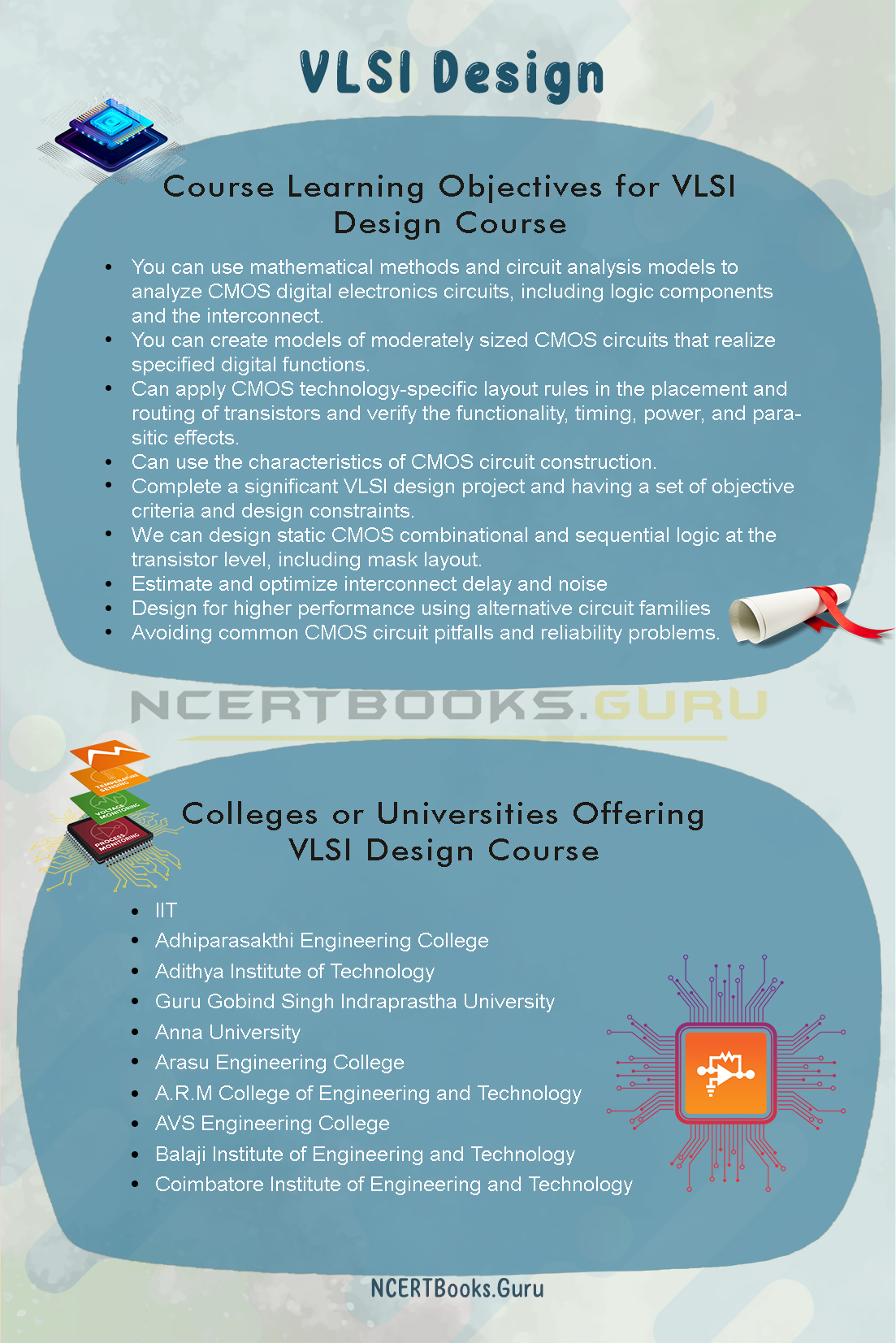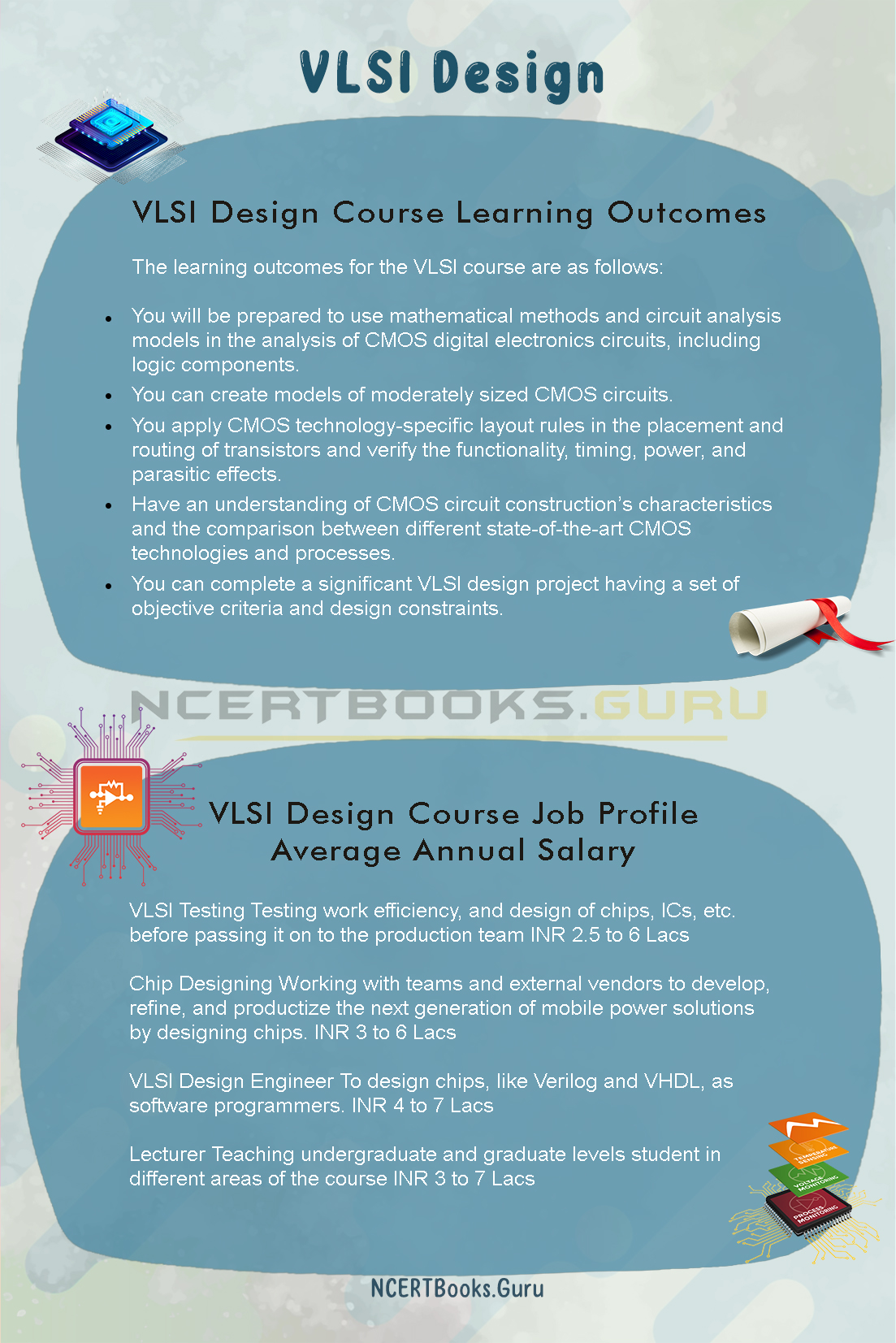VLSI Design Course: VLSI Stands for Very-large-scale integration (VLSI), which creates an integrated circuit (IC) by combining millions of MOS( Metal Oxide Silicon transistor)transistors over a single chip. VLSI started in the 1970s when MOS ( Metal Oxide Silicon transistor) integrated circuit chips were broadly adopted, enabling compound semiconductor and telecommunication technologies to be explained. The microprocessor and memory chips are VLSI (Very-large-scale integration) devices. Before the intro of VLSI technology, most ICs had a limited set of roles they could perform.
IC (Integrated Circuits)are used in various types of electronic devices. Our mobile phone consists of IC. IC is a circuit where all or some of the circuit elements are inseparably linked and electrically interconnected, so it’s considered indivisible for construction and commerce. Before VLSI, IC size used to be much larger than it is now. Because of VLSI, designers can now add millions of transistors and other components on a tiny chip.
- VLSI Course Details Eligibility
- VLSI Design Courses in India
- List of VLSI Course Topics
- Course Learning Objectives for VLSI Design Course
- Assignments and Project
- VLSI Design Course Duration
- Colleges or Universities Offering VLSI Design Course
- Entrance Exams for VLSI Design Course
- VLSI Design Course Learning Outcomes
- VLSI Design Course Highlights
- VLSI Course Design Career Prospects
- VLSI Design Course Job Profile Average Annual Salary
- What is a VLSI Design?
- What are the uses of VLSI Design?
- What are the career prospects of VLSI?
- Name some colleges or Universities of Abroad for the VLSI Design course?
A Brief on Very-Large-Scale Integration (VLSI) Design Course
Very-large-scale or VLSI integration was made feasible with the wide choice of the MOS transistor, invented initially by Mohamed M. Atalla and Dawon Kahng at Bell Labs in 1959. Atalla first proposed the MOS integrated circuit chip concept in 1960, and then it was followed by Kahng in 1961, both noted that the MOS transistor ease of fabrication made it useful for integrated circuits. In 1964 General Microelectronics introduced the first commercial MOS integrated circuit. In 1970, MOS integrated circuit technology allowed integrating more than 10,000 transistors in a single chip. This covered the way for VLSI in the 1970s and 1980s, with tens of thousands of MOS transistors on a single chip (later thousands, then millions, and now billions).
VLSI is how an integrated circuit is created by combining millions of transistors into a single chip. This design has become the most happening electronics field. It is finding its application in a different range of electrical equipment like computer peripherals, cell phones, consumer electronics satellites, defense aerospace, set-top entertainment boxes, and several other devices. VLSI helps designers add components on a chip so that no compromise has to be made on fronts such as size, cost of production, and performance.
VLSI Course Details Eligibility
Graduates hailing from similar branches of engineering and science backgrounds can pursue a VLSI course. Some of the courses are
- Computer Science
- Information Technology
- Electrical
- Telecommunication
- Instrumentation
- Electronics
Eligibility criteria may differ from one course to another. The eligibility criteria of different courses are discussed in details ahead.
VLSI Design Courses in India
- M.TECH. IN VLSI DESIGN AND TECHNOLOGY
- M.TECH. IN VLSI DESIGN
- PG. DIPLOMA IN VLSI DESIGN
- PG CERTIFICATE IN VLSI DESIGN
- MODULAR COURSES
- M.E. IN VLSI DESIGN
- M.SC IN VLSI DESIGN AND TECHNOLOGY
The Eligibility for all the courses above is the same. Eligibility Criteria for the course is a minimum of 50% (relaxable for reserved category candidates) marks at UG level is the least, which almost all the institutes require from applying candidates.
List of VLSI Course Topics
- Introduction to VLSI Systems
- CMOS logic, fabrication, and layout
- MOS Transistor theory
- Layout Design Rules
- Circuit characterization and performance estimation
- Circuit Simulation
- Combinational and sequential circuit design
- Memory system design
- Design methodology and tools
Course Learning Objectives for VLSI Design Course
- You can use mathematical methods and circuit analysis models to analyze CMOS digital electronics circuits, including logic components and the interconnect.
- You can create models of moderately sized CMOS circuits that realize specified digital functions.
- Can apply CMOS technology-specific layout rules in the placement and routing of transistors and verify the functionality, timing, power, and parasitic effects.
- Can use the characteristics of CMOS circuit construction.
- Complete a significant VLSI design project and having a set of objective criteria and design constraints.
- We can design static CMOS combinational and sequential logic at the transistor level, including mask layout.
- Estimate and optimize interconnect delay and noise
- Design for higher performance using alternative circuit families
- Avoiding common CMOS circuit pitfalls and reliability problems.
- Comparing the tradeoffs of sequencing elements including flip-flops, transparent latches, and pulsed latches
- We can also Design functional units, including adders, multipliers, ROMs, SRAMs, and PLAs.
Assignments and Project
- Before each lecture in the VLSI Design Course, a reading assignment is assigned for the subject or the course
- The Course project is to design a reasonably complex digital circuit. The project will be delivered as a team of two or three students.
VLSI Design Course Duration
Most of the colleges have a two years degree course on VLSI. You should check the exact duration of the college’s website for the Courses.
Colleges or Universities Offering VLSI Design Course
- IIT
- Adhiparasakthi Engineering College
- Adithya Institute of Technology
- Guru Gobind Singh Indraprastha University
- Anna University
- Arasu Engineering College
- A.R.M College of Engineering and Technology
- AVS Engineering College
- Balaji Institute of Engineering and Technology
- Coimbatore Institute of Engineering and Technology
Some of the best colleges in abroad to study VLSI are
- Arizona State University
- Columbia University
- Clemson University Boston University
- KTH (Sweden)
- University of Edinburg (UK)
- Bangor University (UK), etc

See More:
Entrance Exams for VLSI Design Course
- GATE(Graduate Aptitude Test in Learning).
- GGSIPU Engineering CET Entrance Examination.
- IIT entrance exam for the Indian Institute of Information Technology.
- BITSAT for Birla Institute of Science &Technology
VLSI Design Course Learning Outcomes
The learning outcomes for the VLSI course are as follows:
- You will be prepared to use mathematical methods and circuit analysis models in the analysis of CMOS digital electronics circuits, including logic components.
- You can create models of moderately sized CMOS circuits.
- You apply CMOS technology-specific layout rules in the placement and routing of transistors and verify the functionality, timing, power, and parasitic effects.
- Have an understanding of CMOS circuit construction’s characteristics and the comparison between different state-of-the-art CMOS technologies and processes.
- You can complete a significant VLSI design project having a set of objective criteria and design constraints.
VLSI Design Course Highlights
| Course Level | Postgraduate |
| Duration | 2 years |
| Eligibility | Graduation degree in B.E/B. Tech |
| Admission Process | Counseling after taking the entrance test |
| Course Fee | INR 1 to 5 Lacs |
| Average Starting Salary | INR 3 to 8 Lacs |
| Major Entrance Exams | GATE, BITSAT, GGSIPU, etc. |
| Examination Type | Semester System |
VLSI Course Design Career Prospects
With modern improvements in areas such as hardware-software co-design, network on chip, an architecture for machine intelligence, etc., VLSI Design is fast, developing as a promising professional field for the subject’s postgraduates.
VLSI Design Courses are
- M.Tech. VLSI Design and Embedded Systems
- M.Tech. Power Electronics and Drives
- M.E. VLSI Design
VLSI Design Course Job Profile Average Annual Salary
VLSI Testing Testing work efficiency, and design of chips, ICs, etc. before passing it on to the production team INR 2.5 to 6 Lacs
Chip Designing Working with teams and external vendors to develop, refine, and productize the next generation of mobile power solutions by designing chips. INR 3 to 6 Lacs
VLSI Design Engineer To design chips, like Verilog and VHDL, as software programmers. INR 4 to 7 Lacs
Lecturer Teaching undergraduate and graduate levels student in different areas of the course INR 3 to 7 Lacs

FAQ’s on VLSI Design Course
Question 1.
What is a VLSI Design?
Answer:
VLSI creates an integrated circuit (IC) by combining millions of MOS( Metal Oxide Silicon transistor)transistors over a single chip. Its full form is Very-large-scale integration.
Question 2.
What are the uses of VLSI Design?
Answer:
VLSI circuits are used everywhere, and real applications include microprocessors in a personal computer or workstation, chips in a graphic card, digital camera or camcorder, chips in a cell phone, or a portable computing device and embedded processors in an automobile, etc.
Question 3.
What are the career prospects of VLSI?
Answer:
VLSI Design is fast, developing in the professional field. It uses mathematical methods and circuit analysis models in the analysis of CMOS digital electronics circuits, including logic components.
Question 4.
Name some colleges or Universities of Abroad for the VLSI Design course?
Answer:
- Karlsruhe Institute of Technology (Germany)
- TU Delft (Netherlands)
- KU Leuven (Belgium)
- TU Chemnitz (Germany)
- KTH (Sweden), etc.
- University of Edinburg (UK)
- Bangor University (UK)
